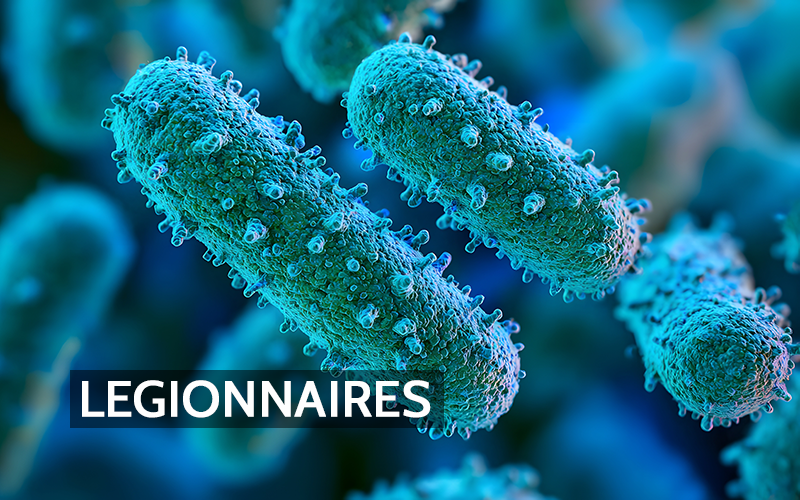Legionnaires’ disease is a severe form of pneumonia caused by the bacterium Legionella pneumophila. This pathogen thrives in freshwater environments but becomes a health hazard when it multiplies in man-made water systems. Understanding how to prevent its spread is critical for public safety.
What Causes Legionnaires’ Disease
Legionella pneumophila naturally inhabits freshwater environments like lakes and streams. While typically harmless in nature, the bacterium becomes problematic in artificial water systems, such as cooling towers, hot tubs, and plumbing networks, especially in warm conditions between 77°F and 113°F. Factors such as stagnant water, biofilms, and inadequate disinfection promote bacterial growth. Infection occurs through inhalation of aerosolized water droplets containing the bacteria1.
Prevalence in the United States
The incidence of Legionnaires’ disease has risen significantly in the United States over the past two decades. According to the Centers for Disease Control and Prevention (CDC), reported cases increased from about 1,100 in 2000 to over 9,900 in 20182. This growth is attributed to factors such as aging water infrastructure, more robust testing and reporting, and a growing population of vulnerable individuals, including older adults and those with compromised immune systems. Seasonal patterns also emerge, with most cases occurring in the summer and early fall when conditions favor Legionella growth.
Transmission of Legionnaires’ Disease
Legionnaires’ disease spreads primarily through the inhalation of aerosolized water droplets containing Legionella bacteria. Common sources include:
- Cooling Towers: Often part of large air-conditioning systems, these towers can release contaminated droplets over wide areas3.
- Hot Tubs and Spas: Poorly maintained units may harbor Legionella bacteria, leading to outbreaks among users.
- Plumbing Systems: Complex water systems in hospitals, hotels, and cruise ships can become reservoirs for the bacteria if improperly managed1.
It is important to note that Legionnaires’ disease is not spread from person to person. The environmental transmission emphasizes the critical need for diligent water system maintenance.
Historical Context in the U.S.
Legionnaires’ disease was first recognized during a 1976 outbreak at an American Legion convention in Philadelphia, where 182 attendees were infected, and 29 died. The investigation led to the identification of Legionella pneumophila as the causative agent4. Since then, several notable outbreaks have occurred. For example, a 2015 outbreak in New York City linked to a contaminated cooling tower resulted in 138 cases and 16 deaths, highlighting the ongoing challenge posed by this disease5.
Detection and Monitoring Programs in the U.S.
The United States has developed robust detection and monitoring systems for Legionnaires’ disease. The CDC oversees data collection through the National Notifiable Diseases Surveillance System (NNDSS) and the Supplemental Legionnaires’ Disease Surveillance System (SLDSS)6. These systems provide detailed insights into national case trends, sources of exposure, and disease severity.
Outbreak investigations are essential to identify sources of contamination and implement control measures. Surveillance programs aim to quickly detect new cases and epidemiological links, enabling prompt action. For example, the CDC’s Environmental Legionella Isolation Techniques Evaluation (ELITE) program helps test laboratories evaluate water systems for Legionella contamination7.
Preventive Measures
Preventing Legionnaires’ disease requires proactive water system management to inhibit Legionella growth. Guidelines recommend regular cleaning and disinfection of cooling towers, hot tubs, and plumbing systems. Maintaining proper water temperatures and disinfectant levels is also crucial. In healthcare settings, stringent water management practices are essential to protect high-risk individuals.
The CDC encourages the development of water management programs for building owners and facility managers. These programs involve identifying hazardous conditions, implementing corrective actions, and monitoring water systems to prevent bacterial proliferation1.
Legionnaires’ disease remains a growing public health concern in the United States. The combination of increased case reporting, aging infrastructure, and a vulnerable population underscores the need for continued vigilance. Strong detection and monitoring programs, coupled with effective water management, are critical to reducing the disease’s impact and safeguarding public health.
Related Articles:
History, Spread, and Prevention of Influenza in the U.S.
Causes, Transmission, History, and U.S. Detection and Monitoring Programs
References:
- https://www.cdc.gov/legionella/index.html
- https://www.cdc.gov/vitalsigns/legionnaires/index.html
- https://www.epa.gov/legionella
- https://www.ncbi.nlm.nih.gov/pmc/articles/PMC4791843/
- https://www.nytimes.com/2015/08/13/nyregion/legionnaires-outbreak.html
- https://www.cdc.gov/nndss/
- https://www.cdc.gov/legionella/elite.html


